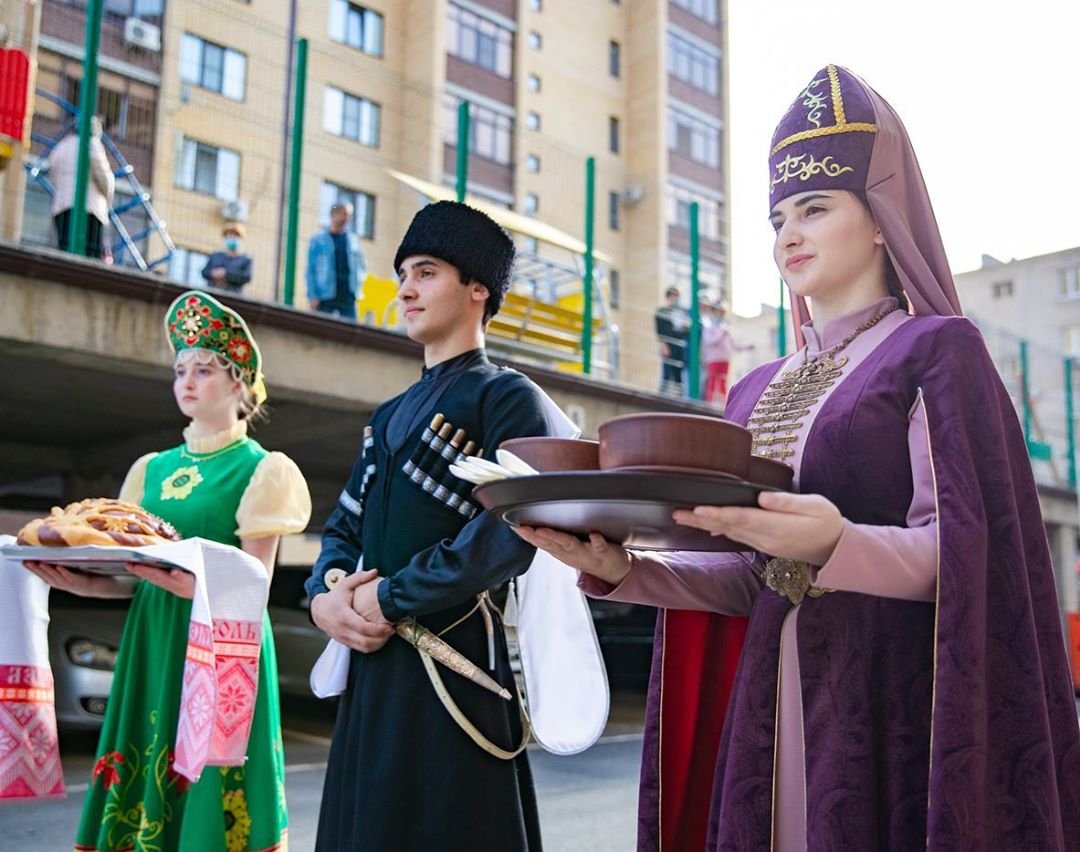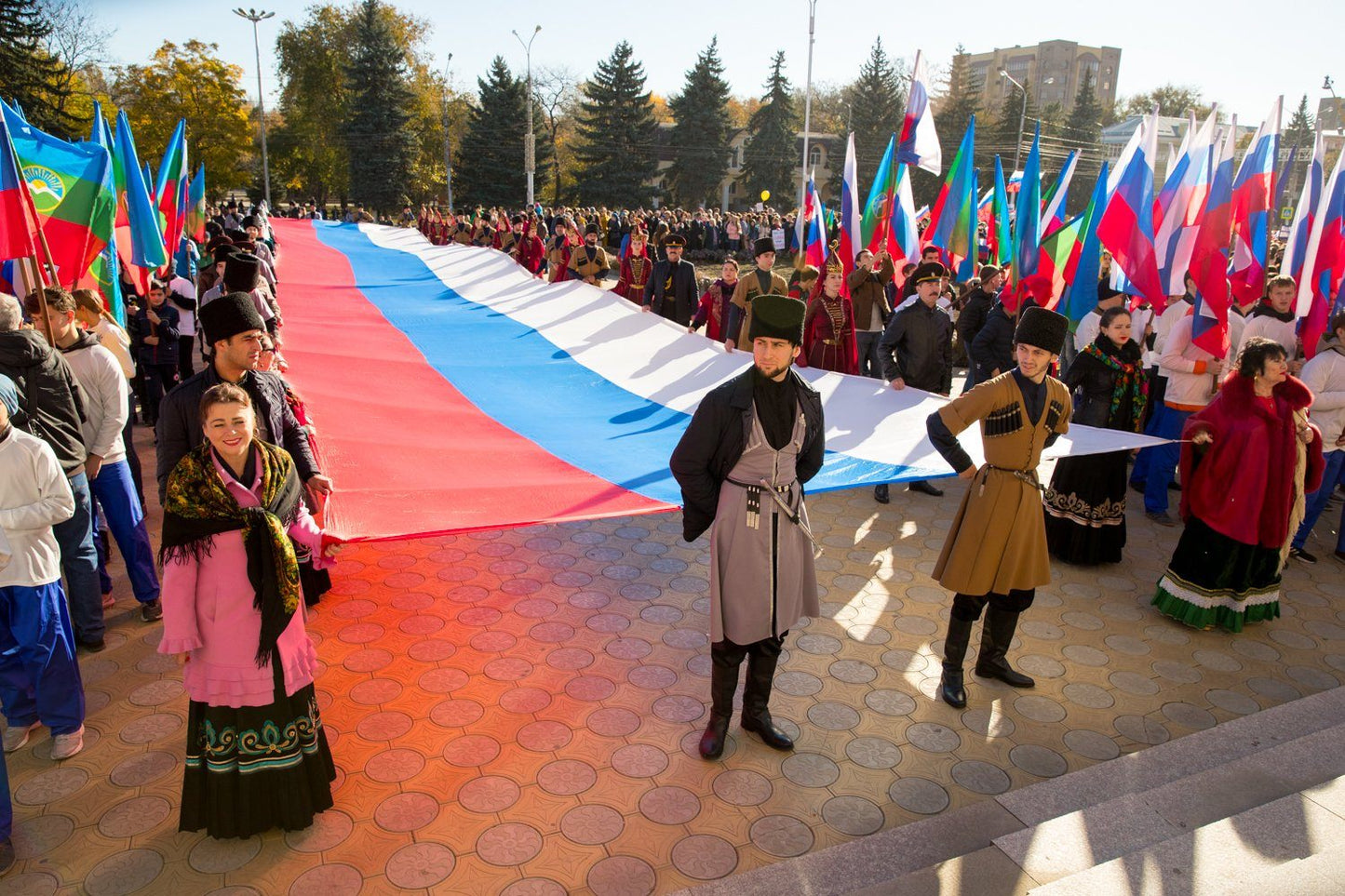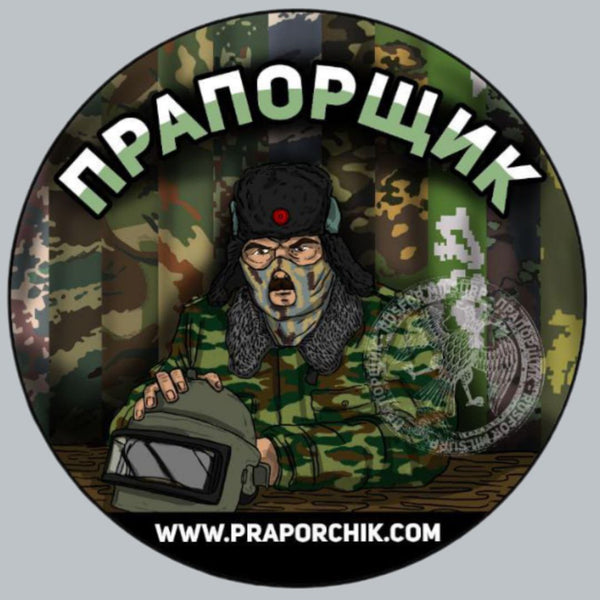Prapor
Karachay-Cherkessia Republic Flag 60x90cm
Karachay-Cherkessia Republic Flag 60x90cm
Couldn't load pickup availability
Orgin: PRC.
Fabric: Polyester.
Size: 60x90cm
State: New.
Flag of the Republic Karachay Cerkicya, located in North Caucasus.
Karachay-Cherkessia (Russian: Карачаево-Черкесия, romanized: Karachayevo-Cherkesiya), officially known as the Karachay-Cherkess Republic, is a republic in Russia situated in the North Caucasus. It is part of the North Caucasian Federal District. As of the 2021 (*census), Karachay-Cherkessia is home to 469,865 people. The capital and largest city is Cherkessk. Karachay-Cherkessia is an ethnic republic in Russia, mainly representing the indigenous Caucasian-Turkic Karachay people and the Cherkess or Circassian people. The largest ethnic group is the Karachays, making up around 44% of the population, followed by ethnic Russians (27%) and Cherkess (13%). The Cherkess people are primarily from the Besleney and Kabardin tribes. The official languages of the
Geography

The republic is situated in the northwestern Caucasus and shares borders with Krasnodar Krai to the west and northwest, the Kabardino-Balkar Republic to the southeast, Georgia (including Abkhazia) to the south and west, and Stavropol Krai to the northeast. It spans 140 kilometers (87 mi) from north to south and 170 kilometers (110 mi) from east to west. Approximately 80% of its land is covered by mountains; the highest peak in the Caucasus, Mount Elbrus at 5,642 meters (18,510 ft), is located on its border with Kabardino-Balkaria. There is an abundance of water resources, including 172 rivers such as the Kuban, Bolshoy Zelenchuk, Maly Zelenchuk, Urup, and Laba. The region also boasts 130 glacial lakes and numerous mineral springs. The climate is moderate, with short winters and
Karachay-Cherkessia is the only region in the North Caucasian Federal District that does not have an airport.
History The Karachay-Cherkess Autonomous Oblast was established on January 12, 1922, during the early years of the Soviet Union. It was divided into Karachay Autonomous Oblast and Cherkess National Okrug on April 26, 1926. The Cherkess National District was then elevated to an autonomous oblast on April 30, 1928. However, the Karachay Autonomous Oblast was abolished in November 1943 after allegations of Nazi collaboration and the deportation of 70,000 Karachay people to other republics. The remaining territory was split between Stavropol Krai and the Georgian SSR. In January 1957, the Cherkess Autonomous Oblast was incorporated into Karachay-Cherkess Autonomous Oblast in its original borders after the rehabilitation of the Karachay. On July 3, 1991, the autonomous oblast was upgraded to the status of the Autonomous Soviet Socialist Republic of Karach

Population: 469,865 (2021 Census); 477,859 (2010 Russian census); 439,470 (2002 Census); 417,560 (1989 Soviet census).
| Year | Pop. | ±% |
|---|---|---|
| 1926 | 101,609 | — |
| 1939 | 246,000 | +142.1% |
| 1959 | 277,959 | +13.0% |
| 1970 | 344,651 | +24.0% |
| 1979 | 368,343 | +6.9% |
| 1989 | 417,560 | +13.4% |
| 2002 | 439,470 | +5.2% |
| 2010 | 477,859 | +8.7% |
| 2021 | 469,865 | −1.7% |
| Source: Census data | ||
Life expectancy:
| 2019 | 2021 | |
|---|---|---|
| Average: | 76.2 years | 73.5 years |
| Male: | 71.7 years | 69.3 years |
| Female: | 80.4 years | 77.3 years |
Vital statistics
| Average population (x 1000) | Live births | Deaths | Natural change | Crude birth rate (per 1000) | Crude death rate (per 1000) | Natural change (per 1000) | Total fertility rate | |
|---|---|---|---|---|---|---|---|---|
| 1970 | 346 | 6,021 | 2,153 | 3,868 | 17.4 | 6.2 | 11.2 | |
| 1975 | 357 | 6,619 | 2,288 | 4,331 | 18.5 | 6.4 | 12.1 | |
| 1980 | 373 | 7,044 | 2,794 | 4,250 | 18.9 | 7.5 | 11.4 | |
| 1985 | 394 | 8,119 | 3,350 | 4,769 | 20.6 | 8.5 | 12.1 | |
| 1990 | 422 | 7,218 | 3,496 | 3,722 | 17.1 | 8.3 | 8.8 | |
| 1991 | 427 | 7,145 | 3,713 | 3,432 | 16.7 | 8.7 | 8.0 | |
| 1992 | 431 | 6,846 | 3,915 | 2,931 | 15.9 | 9.1 | 6.8 | |
| 1993 | 433 | 5,569 | 4,336 | 1,233 | 12.9 | 10.0 | 2.8 | |
| 1994 | 434 | 5,786 | 4,598 | 1,188 | 13.3 | 10.6 | 2.7 | |
| 1995 | 437 | 5,633 | 4,501 | 1,132 | 12.9 | 10.3 | 2.6 | |
| 1996 | 439 | 5,281 | 4,683 | 598 | 12.0 | 10.7 | 1.4 | |
| 1997 | 440 | 4,987 | 4,615 | 372 | 11.3 | 10.5 | 0.8 | |
| 1998 | 441 | 4,990 | 4,537 | 453 | 11.3 | 10.3 | 1.0 | |
| 1999 | 441 | 4,523 | 4,707 | −184 | 10.3 | 10.7 | −0.4 | |
| 2000 | 440 | 4,666 | 4,961 | −295 | 10.6 | 11.3 | −0.7 | |
| 2001 | 440 | 4,778 | 4,911 | −133 | 10.9 | 11.2 | −0.3 | |
| 2002 | 440 | 4,927 | 5,207 | −280 | 11.2 | 11.8 | −0.6 | |
| 2003 | 442 | 5,088 | 5,427 | −339 | 11.5 | 12.3 | −0.8 | |
| 2004 | 446 | 5,190 | 5,059 | 131 | 11.6 | 11.3 | 0.3 | |
| 2005 | 450 | 5,194 | 5,131 | 63 | 11.5 | 11.4 | 0.1 | |
| 2006 | 454 | 5,032 | 4,924 | 108 | 11.1 | 10.8 | 0.2 | |
| 2007 | 459 | 6,066 | 4,626 | 1,440 | 13.2 | 10.1 | 3.1 | |
| 2008 | 465 | 6,364 | 4,731 | 1,633 | 13.7 | 10.2 | 3.5 | |
| 2009 | 470 | 6,200 | 4,711 | 1,489 | 13.2 | 10.0 | 3.2 | 1.55 |
| 2010 | 476 | 6,139 | 4,737 | 1,402 | 12.9 | 10.0 | 2.9 | 1.51 |
| 2011 | 477 | 6,289 | 4,664 | 1,625 | 13.1 | 9.7 | 3.4 | 1.54 |
| 2012 | 475 | 6,499 | 4,633 | 1,866 | 13.7 | 9.8 | 3.9 | 1.63 |
| 2013 | 471 | 6,547 | 4,464 | 2,083 | 13.9 | 9.5 | 4.4 | 1.67 |
| 2014 | 470 | 6,318 | 4,553 | 1,765 | 13.5 | 9.7 | 3.8 | 1.65 |
| 2015 | 468 | 5,803 | 4,523 | 1,280 | 12.4 | 9.6 | 2.8 | 1.54 |
| 2016 | 467 | 5,575 | 4,393 | 1,182 | 11.9 | 9.4 | 2.5 | 1.52 |
| 2017 | 466 | 5,145 | 4,346 | 799 | 11.0 | 9.3 | 1.7 | 1.43 |
| 2018 | 465 | 4,974 | 4,137 | 837 | 10.7 | 8.9 | 1.8 | 1.43 |
| 2019 | 5,050 | 4,219 | 831 | 10.8 | 9.1 | 1.7 | 1.48 | |
| 2020 | 5,135 | 5,034 | 101 | 11.0 | 10.8 | 0.2 | 1.53 | |
| 2021 | 4,470 | 5,677 | -1,207 | 9.6 | 12.2 | -2.6 | 1.35 | |
| 2022 | 4,429 | 4,460 | -31 | 9.5 | 9.6 | -0.1 | 1.30 | |
| 2023 | 4,413 | 3,974 | 439 | 9.4 | 8.5 | 0.9 | 1.34 |
Sources: 1970 to 2008;[25] 2009–2013;[26] 2014–...[citation needed]
Ethnic groups
According to the 2021 Census, Karachays make up 44.4% of the republic's population, followed by Russians (27.5%), and Cherkess and Abazins together make up 20.8%.
| Ethnic group |
1926 Census1 | 1939 Census | 1959 Census | 1970 Census | 1979 Census | 1989 Census | 2002 Census | 2010 Census | 2021 Census3 | |||||||||
|---|---|---|---|---|---|---|---|---|---|---|---|---|---|---|---|---|---|---|
| Number | % | Number | % | Number | % | Number | % | Number | % | Number | % | Number | % | Number | % | Number | % | |
| Karachays | 53,175 | 31.3% | 70,932 | 29.2% | 67,830 | 24.4% | 97,104 | 28.2% | 109,196 | 29.7% | 129,449 | 31.2% | 169,198 | 38.5% | 194,324 | 41.0% | 205,578 | 44.4% |
| Cherkess | 16,1862 | 9.5% | 17,667 | 7.3% | 24,145 | 8.7% | 31,190 | 9.0% | 34,430 | 9.4% | 40,241 | 9.7% | 49,591 | 11.3% | 56,466 | 11.9% | 58,825 | 12.7% |
| Abazins | 13,731 | 8.1% | 14,138 | 5.8% | 18,159 | 6.5% | 22,896 | 6.6% | 24,245 | 6.6% | 27,475 | 6.6% | 32,346 | 7.4% | 36,919 | 7.8% | 37,664 | 8.1% |
| Russians | 40,072 | 23.6% | 118,785 | 48.8% | 141,843 | 51.0% | 162,442 | 47.1% | 165,451 | 45.1% | 175,931 | 42.4% | 147,878 | 33.6% | 150,025 | 31.6% | 127,621 | 27.5% |
| Nogais | 6,263 | 3.7% | 6,869 | 2.8% | 8,903 | 3.2% | 11,062 | 3.2% | 11,872 | 3.2% | 12,993 | 3.1% | 14,873 | 3.4% | 15,654 | 3.3% | 17,368 | 3.7% |
| Ukrainians | 32,518 | 19.1% | 4,104 | 1.7% | 4,011 | 1.4% | 4,819 | 1.4% | 4,555 | 1.2% | 6,308 | 1.5% | 3,331 | 0.8% | 1,990 | 0.4% | 787 | 0.2% |
| Others | 8,082 | 4.8% | 10,703 | 4.4% | 13,068 | 4.7% | 15,138 | 4.4% | 17,362 | 4.7% | 22,573 | 5.4% | 22,253 | 5.1% | 18,892 | 4.0% | 15,425 | 3.3% |
|
1 The results of the 1926 census refer to the present territory, which is a combination of the Cherkess ND, the Karachay AO and adjacent areas. The latter areas were mainly inhabited by Russians and Ukrainians.[28]
2 13,496 Kabardins and 2,690 other Cherkess. 3 6,597 people were registered from administrative databases, and could not declare an ethnicity. It is estimated that the proportion of ethnicities in this group is the same as that of the declared group. |
||||||||||||||||||
Religion[edit]
| Religion in Karachay-Cherkessia as of 2012 (Sreda Arena Atlas)[30][31] | ||||
|---|---|---|---|---|
| Islam |
|
64% | ||
| Russian Orthodoxy |
|
13.2% | ||
| Spiritual but not religious |
|
10% | ||
| Other and undeclared |
|
6% | ||
| Atheism and irreligion |
|
3% | ||
| Native faiths |
|
2% | ||
| Other Christians |
|
1.8% | ||
Notable people
-
Zuhra Bayramkulova - Dairy farmer and Hero of Socialist Labour.
*Census. Like all ethnic minorities both during Soviet Union and under Russian rule...well...no comment..
Hang this flag high and proud.
This flag is sold purely as historical item, not supporting any poltical agenda.
Share
















